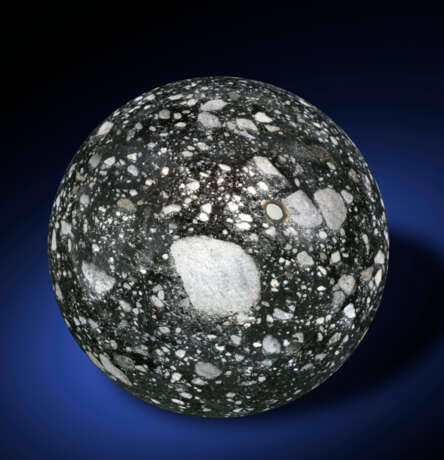ID 927036
Lot 45 | NWA 12691 — THE MOON FASHIONED INTO A SPHERE
Estimate value
$ 60 000 – 100 000
While that sounds like a lot, less than 1400 kg of the Moon is known to exist on Earth and every single bit could fit in the back of a large SUV. While Apollo astronauts returned with 382 kg of Moon rocks, not one gram is available for private ownership. Of the 800 kg of lunar meteorites, i.e., pieces of the Moon ejected off the lunar surface following an asteroid impact (and nearly all of the craters on the Moon are the result of such impacts), a good deal of that material is also locked away in the world’s great museums and research institutions.
It’s only because of the relatively large amount of material recovered in the NWA 12691 megafind that the opportunity to fashion a limited number of lunar spheres exists: the trimming, grinding and polishing regimens result in a great deal of material loss in a sphere’s fabrication. As there is more than enough lunar material from this event to satisfy the needs of research, the conservatorship of this meteorite has been addressed — and it may be decades before another lunar meteorite with a sufficiently high total known weight will be found to provide the possibility of additional spheres. In short, spherular presentations of the Moon are very limited.
Scientists identify Moon rocks by specific textural, mineralogical, chemical, and isotopic signatures. Many of the common minerals found on Earth’s surface are rare or absent on the Moon. and some lunar minerals are unknown on Earth. As one would expect, many of the Moon rocks returned by Apollo missions are nearly identical to lunar meteorites — which does apply to the sphere now offered.
NWA 12691 is the 12,691st meteorite to be found in the North West African corridor of the Sahara Desert, that is analyzed, peer reviewed and approved for publication in the Meteoritical Bulletin, the journal of record.
NWA 12691 is composed of fragments of olivine, pigeonite, augite, ilmenite and signature white anorthite naturally cemented together by what was a melt of lunar regolith and other crushed rock. A large nodule of iron is readily seen which had to originate from an asteroid having impacted the Moon. The brecciation in evidence is the result of the ongoing bombardment of such asteroids prior to the impact responsible for launching this rock to Earth. Featuring a high polish and sharp contrast between the white anorthite and lunar regolith, this is a superior spherical sample of the Moon — evocative of the Moon itself. Modern fashioning.
The official classification of the material from which this sphere was hewn was performed by Dr. Anthony Irving, the world’s foremost classifier of lunar and Martian meteorites. His work underwent peer review prior to publication in the 108th edition of the Meteoritical Bulletin.
Christie's would like to thank Dr. Alan E. Rubin at the Department of Earth, Planetary, and Space Sciences, University of California, Los Angeles for his assistance in preparing this catalogue.
67mm (2.66 in.) in diameter and 444.1 grams (1 lb)
| Address of auction |
CHRISTIE'S 20 Rockefeller Plaza 10020 New York USA | ||||||||||||||
|---|---|---|---|---|---|---|---|---|---|---|---|---|---|---|---|
| Preview |
| ||||||||||||||
| Phone | +1 212 636 2000 | ||||||||||||||
| Fax | +1 212 636 4930 | ||||||||||||||
| Conditions of purchase | Conditions of purchase | ||||||||||||||
| Shipping |
Postal service Courier service pickup by yourself | ||||||||||||||
| Payment methods |
Wire Transfer | ||||||||||||||
| Business hours | Business hours
|




